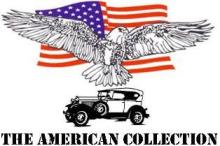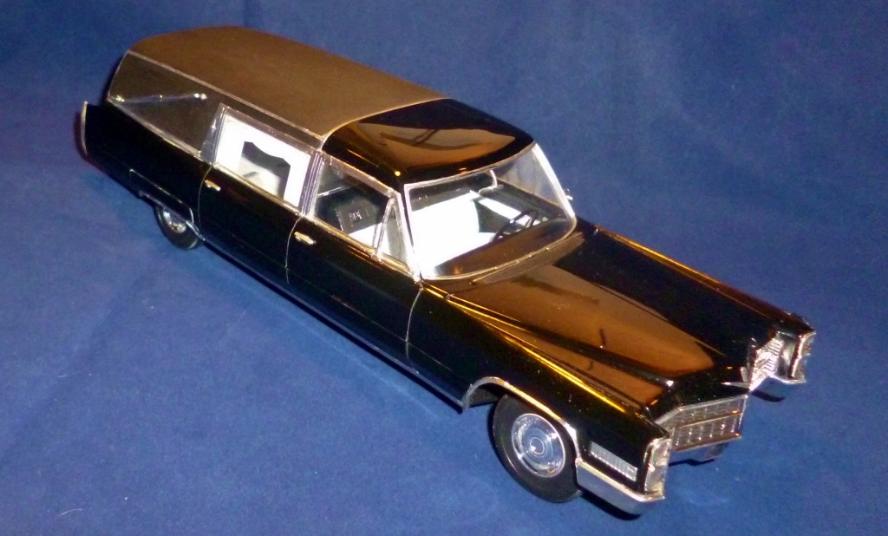
1966 Miller-Meteor Cadillac funeral coach
Vehicles with specific uses are, more often than not, the result of a combination of the work of a number of companies. Think Thornycroft-Nubian Fire Appliances, Thornycroft-Coles cranes, Carmichael-Dennis and numerous specialist coach builders putting bodies on chassis for anything from hunting game to towing gliders. This particular vehicle combines an unprecedented number of companies to tell the story that ultimately provides the final transportation for most people, a hearse; or a funeral coach, if you prefer.
Cadillac
In March 1902 Henry Ford, and several of his investors, left the Henry Ford Company. William Murphy and Lemuel Bowen were now left with a manufacturing company but no designer and being financially minded people decided to have the value of the company’s assets appraised prior to liquidation of the company. For this task they called upon the services of Leland & Faulconer Manufacturing Company. Henry M. Leland, a competent engineer in his own right, duly went along and had a good nose around. His report rather stunned Murphy and Bowen; instead of proffering advice to sell off the Henry Ford Company assets he suggested they continue manufacturing motor cars. In short, he thought it would be better to use the proven Leland and Faulconer single-cylinder engine in the existing Ford chassis but sell them as “Cadillac” automobiles. So it was, that the Cadillac Automobile Company was established on the 22nd of August 1902. Why the name Cadillac? Well, they were in Detroit and Detroit was founded by the French explorer Antoine Laumet de La Mothe, sieur de Cadillac. Today this might be seen as a strange choice as we know much more of Antoine Laumet’s shady past but in 1902 he was still considered a full-on hero by many people and would certainly have been a known name in the area.
Working out of the old Ford factory on Cass Avenue and Amsterdam street Cadillac produced their first car on the 17th of October 1902, although the precise date has also been quoted as the 16th (car #3!) or the 20th of October. These first cars were two-seat, 10hp Runabouts and Tonneaus virtually the same as the previous Fords; and identical to the 1903 Ford Model A.
Henry Leland held almost a polar opposite opinion of car manufacturing to Henry Ford. While Ford thought mass production and low price was the route to success Leland believed small numbers of extremely high-quality machines was the correct path to success. As it happens, both were right!
Cadillac showed its wares to the world at the 1903 New York Auto Show. They were exceptionally well made and would prove to be very reliable. The visiting crowds were impressed enough for the company to garner over 2,000 firm orders. Leland was also one of the earliest proponents of parts interchangeability and coupled to high quality engineering would establish Cadillac as a top-flight prestige manufacturer, rivalling even Rolls-Royce, and win Cadillac the Dewar Trophy twice. Cadillac even coined a new advertising slogan building upon this reputation for high quality and innovation. "Standard of the World". It was a well-founded claim too, Cadillac were early manufacturers of full electrical systems, smooth changing “classless” gearboxes, V8 engines and incorporated steel roofs.
Like Rolls-Royce, a Cadillac was undoubtedly a respectful chassis upon which to send a loved on to their final resting place.
Miller
Carriage and coachbuilders A. J. Miller Company of Bellefontaine, Ohio, had been in business since 1853. Apparently, the firm did rather well as a small branch factory was established in Muncie, Indiana in the 1860s; however, this factory was sold to two of the employees, William Kinsley and William H. Knapp. Miller started making funeral coaches from around 1870.
As the world moved on to the use of motor vehicles so the Miller moved into that world too, while continuing its traditional lines of course. A. J. Miller became president of Bellefontaine Automobile company who built luxury automobiles, in small numbers from 1908 but the company passed to other hands and had a short history which concluded in 1916.
Predictably the small Miller company found it harder and harder to compete with the large motor companies and horse drawn vehicle sales dwindled. By 1914 Miller were specializing in hearse and ambulance bodies when Maurice Wolfe of the Meteor Car Company in Piqua, Ohio, came calling. He wanted to do a deal with Millar to have them supply professionally built Miller car bodies to fit upon his Meteor chassis, in return Miller would get Meteor chassis to build their cars on. Miller agreed, but this was not the start of the famous Miller-Meteor company we knew later. This co-operation lasted only to 1917 when Miller decided they could build the chassis as well as the bodies and went into the luxury car market themselves. This seems to coincide with the aforementioned Bellefontaine Automobile Company having moved on and there being local skilled workers available.
Miller produced a long wheel base chassis with a 52hp Continental six-cylinder engines to put hearse coachwork on. This vehicle had eight-columns with plate-glass windows between the 2nd and 3rd column which could be covered with removable panels if required. One particularly noticeable feature was the inclusion of vertical oval windows, just behind the two front doors, making the new hearse a stylish and adaptable funeral coach.
Miller went on produce many vehicles along similar lines and sold hearse bodies to other firms to fit on their own chassis. Dodge commercial chassis, Studebaker Big-Six chassis, Nash Advanced-Six chassis and others carried Miller combination hearse/ambulance bodies as well as a very stylish 7-passenger sedan-ambulance on a Studebaker Six chassis of 126" wheelbase. The company incorporated all sorts of features into their specialist ambulances including sinks with running water and a latch that kept the collapsible Bomgardner wheeled stretcher securely in place. In another innovative step Miller invested in metal-panel stamping equipment to produce stylish bodywork which would previously have taken skilled men hours to work by hand.
Such innovations and investment saw Miller able to sell a stamped metal body mounted on a Packard 6-cyl chassis for $3350, or Packard’s 8-cyl chassis for $4400. If you preferred the Nash Special Six chassis you bring the cost down to $2250. In 1927 Miller was making vehicles, and, making money.
Having seen the crash 1929 Miller managed to remain stable and in 1930/1 was still selling a full product range, although the prices had been reduced to be more affordable. Having said that the prices ranged from a reasonable $2000 for a Miller-Nash Mt. Vernon funeral car, but, the price could be doubled up (and more) for the top of the line Miller-Packard Chief funeral coach, dubbed the "Boss of the Road", which sold for $4600. Continuously responding to motor industry styling traits and customer preferences Miller incorporated leather-covered landau roofs with landau bars, then a few years later dropped the leather look returning to the plain polished black painted version Aerodynamic came and went in the same manner as V-shaped windshields and ugly beaver-tail rears, but Miller kept on producing what the customers needed on Nash, Cadillac, Packard, REO, Pierce-Arrow and even a single Cord L-29 chassis. The lower priced Benjamin Franklin line of 1933 also had the flexibility to be mounted on a number of different chassis, alongside the Nash chassis were Ford, Chevrolet and Dodge based vehicles.
A.J. Miller's company pushed on to the 1940s with a broad product range that included features like arched windows or carved drapery panels placed between the columns which, despite the look of excellently hand carved wood, were still the product of metal stampings. Sometimes the columns, arches and carved drapery inserts would be painted in contrasting colours but for the most part they would be body coloured, most often black or white. Millers eye for market openings even led the company to build an all-white children's hearse on a 1934 Willys chassis.
Later in the 1930s, as roof lines lowered, the wide side loading door was offered. This gave operators more options for loading in tight locations. 100% metal construction became available although the option of fabric tops remained up to 1940. Other options for the Miller vehicles were frosted, etched, or stained-glass side and rear quarter-windows, and full lighting packages for emergency ambulances including spotlights, fog lights, emergency lights and of course the obligatory sirens.
Having the ability to adapt to other markets had served Miller well in the past and in 1937 the company was approached by the Broadmoor Hotel in Colorado Springs, to build a fleet of sightseeing coaches. Miller of course agreed and came up with a design based on the GM commercial chassis, well, a rather lengthened version of it. In fact, Miller was almost completely moved onto GM Chassis in 1938. Anyway, these new coaches were huge, had eight doors and along a roll-back canvas roof.
Another interesting innovation from Miller was their adoption of a record player and amplifier set placed under the passenger of the dashboard and two speakers set under the bonnet. This "Miller Music Master" system allowed music to be played at the graveside.
Going into the 1940s Miller were becoming know the around the world for their funeral coaches, ambulances and service cars. Air conditioning, flower carrying boxes, Hydra-Matic automatic transmission and more streamlined bodies showed the future of the funeral coach, but World War Two would make everyone wait to see what the company would produce next.
Miller invested in new panel stamping equipment during the war as the company produced aluminium boat hulls for the navy and 1-ton 2-wheel travel trailers as a basis for the Signal Corps to put mobile communication centres on. Post war this prudent decision allowed the company to create truly advanced panel stampings the envy of many other motor manufacturers. Chassis usage was now almost exclusively Cadillac and Miller found the market of the late 1940s buoyant. Optional extras abounded and export to other countries, most notably Canada, and prices could be as high as $2,000 more than the same vehicle would have been before the war.
While celebrating their 100th Anniversary in 1953 the A.J. Miller Co found the boom was already slowing and chassis providers were stopping building sedan/delivery vehicles pushing many companies to build on more expensive chassis or commercial vehicle chassis, also more expensive. By the end of 1956 Miller had been acquired by the Wayne corporation, their independence lost.
Meteor
The Meteor brand is attributed to one Maurice Wolfe who shot to notoriety as the Minneapolis car salesman who sold a car to Chief Big Mouth of the Crow tribe from Billings, Montana. The press had a field day reporting on the man who sold a Cadillac to a “wild Indian”. Wolfe later joined John F. and H.E. Wilcox in actual motor car production. From 1907 to 1911 the company produced approximately 180 cars under the advertising slogan of "Absolutely Standard", which on face value sounds rather average but was actually meant to allude to the high quality of the engineering.
In 1911 there was a split between Wilcox brothers and Wolfe. The car company was rebranded as Wilcox Maurice Wolfe moved on to Shelbyville, Indiana, where he purchased the Clark Motor Car Co. at some point in 1912. Wolfe maintained the production of Clark cars until his new brand, ‘The Meteor Motor Car Co.’ was up and running. Business must have been good as Wolfe was soon looking for larger premises in order to expand production. Meteor purchased the Sprague-Smith Furniture Company’s buildings in Piqua, Ohio, where a range of six-cylinder tourers and roadsters were built.
We’ve seen previously that Wolfe did a deal to have bodies from the A.J. Miller Body Company in 1914 so as to produce hearses and ambulances. Putting the Miller Hearse bodies on the Wolfe designed Meteor chassis marked out Meteor as the first suppliers of purpose-built “professional” car. Continuing his innovative ideas Wolfe advertised the Meteor funeral coaches directly to funeral directors through the medium of the specific magazines for funeral companies, such as “Casket & Sunnyside”, “Mortuary Management” and “American Funeral Director”. The company also sent out a bi-monthly newsletter across the U.S.A. reporting on innovations and products.
By using this method of promoting sales Meteor cut out the middle men of dealerships and sales personnel Meteor could keep prices lower than their competitors, a point they made much of in their adverts stressing this was the reason for low prices, not any lowering of quality. Meteor were amongst the first companies to offer special instalment plan finance packages to the older funeral homes moving into the age of the automobile, something GM picked up and copied some years later. Wolfe’s last method to boost sales was to offer his chassis to all of his competitors at a very affordable $1000 direct wholesale price, which effectively meant even if you didn’t get you vehicle from Meteor they still got a cut of the money! The Miller-Meteor combination only lasted from 1914 to 1917 when Miller started using other chassis providers, this led to an animosity between the two companies that lasted for three decades.
Meteor’s 1916 chassis, the Model 85, was a 148" frame carrying a Weidley 72hp, 12-cylinder engine known as the twin-six. The Model 85 chassis was fitted with a combination body for use as a pallbearer’s coach and/or ambulance and as $2,150 the vehicle was still cheaper than any competitors 8 and 6-cyl’ vehicle. Meteor actually had a product range of three “professional cars”, all of which were of equally high quality, and by early 1916 had established themselves as the national favourite in the U.S.A., so much so that by 1917 passenger car production had been reduced a special-order status. Production of the professional car grew to a point that Meteor had back orders pushing delivery times in into months.
Meteors overall product range had to major lines. First was the traditional style 8 pillar carved side panel hearse with luxurious purple and lavender draperies and mahogany panelling inside. They even had leaded glass panels in the roof. Meteors second line was the limousine-style combination hearse or ambulance which was a more modern vehicle for the smaller towns were the funeral car would double as an ambulance or coroners’ vehicle. This line would have a folding stretcher and attendant seats, and two sets of silk drapes (an elaborate funeral set and a plain ambulance set) and flower boxes.
After the disruptions of WWI Meteor found they had to increase their prices due to higher material costs. Modernisation of the range helped boost sales and the addition of Side-loading doors and two wheelbase chassis options helped further enhance the brand. As the years progressed Meteor introduced options like rear compartment windows rather than panels with frosted, leaded or plain glass, extra-long bodies that could seat ten persons or carry two stretchers and an increasing number of colour options and combinations. Style fashions came and went much as they did for Miller and in the end, Meteor became hampered by similar issues of material costs associated with the ever-growing requirements for the latest styling ideas (fins, chrome, landau roof/bars and streamlining) and mod’-cons’ (air conditioning, radios and emergency lighting packages). Mechanically Meteor would work off of Buick, Cadillac, LaSalle and Oldsmobile chassis, some featuring Continental engines, Watson Stabilators, Hydra-Matic automatic transmission and high-end Lockheed four-wheel hydraulic brakes.
In common with Miller, Meteor also made other vehicles in small numbers. In 1939 Meteor built a series of 12 special 12 -seat Cadillac limousines for American Airlines. A streamlined roof rack for luggage was built in and the interior featured the airlines corporate colours. Another unusual Meteor was the extended wheelbase 8-door 1940 LaSalle car commissioned by Ralph Wilson and his wife Matilda Dodge Wilson, the Dodge Bros. heiress. This vehicle had a “Woody” style body and proved to be of great value at the owners Meadowbrook estate where it not only took the servants into town on their days off but also ferried the local football team around. Being able to carry the equivalent two normal cars the LaSalle was particularly economical.
Pursuing other avenues doesn’t always get quick results but can in the long run bring its own reward. In the case of Meteor that would mean their efforts to move into the medium sized bus market with a 29-passenger transit bus. The 1941 prototype, “project 101”, was never more than that but after WWII the experienced the company had gained allowed Meteor to win a contract to produce bodies for Reo coaches. Between 1945 and 1947 Meteor built 969 bus bodies for what became known as the 'Victory' bus or Reo 96-HT. These Reo-Meteor vehicles had 6cyl 427cu Continental engines and sectional bodies of the type developed by the Wayne Works.
The common traits with Miller ended with the fact that chassis providers were stopping building sedan/delivery vehicles pushing many companies to build on more expensive chassis or commercial vehicle chassis, also more expensive. In 1954 Meteor was acquired by the Wayne corporation, their independence, like Millers would soon be, was lost.
Wayne
Like the Miller company Wayne can trace its roots back into the 1800s too. To 1837 in Dublin, Indiana to be precise It was the Witt family who set up a foundry and started making various metal items for the growing colonies migrating across the North American continent. Starting of making stoves the company expanded their range to include the usual sort of farming implements you might expect. As you might also expect, such a company changed hands several times as circumstances changed but it kept going and diversifying until it started producing horse-drawn wagons.
The name “Wayne” came into the story in 1871 when the foundry ownership underwent a reorganization and the new owners chose to name the company after Wayne County, Indiana. Wayne Agricultural Company ultimately relocated to Richmond, Indiana, but during the late 1880s fell on hard times and went into receivership. Fortunately, it was rescued and underwent reorganization out of which “Wayne Works” emerged and started to streamline its operations.
Concentrating more towards the horse-drawn vehicles Wayne works was able to fulfil a commission from an Ohio school district for a form of transport, a wagon with wooden bench style perimeter seating, to bring students into school. This sort of adaptive transport became known variously as "kid hacks", "school hacks".
However, all did not go well for Wayne. A fire completely destroyed the Wayne premises in 1902 and as part of the rebuilding of the company the decision was made to start making automobile bodies, and shortly thereafter, motorcars in full. Prior to WWI Wayne’s bodywork products had move on to commercial vehicle and truck bodies. In 1914 Wayne put a special body onto a Ford Model T chassis to produce their first "School Car". Like the horse-drawn version before it this vehicle was partially enclosed, having no glass in the windows, and had perimeter bench seating, but at least now they did have cushions. Entry for the students was from the rear creating a feature which remains to this day in the form of the rear emergency exit door so common around the world.
After WWI Wayne produced many of these vehicles and also developed it into their 1922 “Touring Home”, one of the earliest motorised recreational vehicles. Continuous development saw Wayne move on to use steel body panels on internal wood frames. Safety was ever on the minds of Wayne designers leading to features like curb side entry, full steel construction, safety glass in the windows and "collision rails" built into the sides. The horse drawn carriage look disappeared completely as the years rolled on and in 1936 Wayne came up with a sectional construction system that helped speed up repairs. The largest school bus Wayne built could carry 115 passengers and as part of a range of sizes available established Wayne as “The” school bus manufacturers.
WWII then interrupted Wayne’s Bus production and the company tooled up for a variety of military vehicles, and, to conserve steel, the firm reverted to wood frames and bodies. Once the war was over Wayne resumed its bus production again with full steel construction. They entered into contracts with Crown on the West Coast and the Welles Corporation of Windsor, Ontario, Canada, as sole distributors in their areas.
In 1950 the Wayne works changed hands marking the end of the Clements family’s ownership, an ownership that had been continuous since 1897. The new owners, the Jeffery Ives Corporation, oversaw a complete redesign of the bus body and were seriously looking at major expansion.
Miller-Meteor
A large proportion of the school bus market now belonged to Wayne and the Ives Corporation but the expansion plans were based around diversification. In this case by acquiring the Meteor Motor Car Company in 1954 and A.J. Miller Company in 1956. The two firms were competitors in the funeral coach market and although they had collaborated in the early 1900s, they had developed a somewhat acrimonious rivalry. In 1956 they were competitors, but, less than a year later they were both part of the same company. Merging the two firms to form Miller-Meteor in 1957, with the production of professional cars, initially at Bellefontaine, Ohio, being transferred close to the earlier Meteor facilities at 125 Clark Avenue, Piqua, Ohio; A.J. Miller's Bellefontaine plant then being sold off.
Miller-Meteor produced professional cars, such as ambulances, limousines and funeral coaches, solely on Cadillac commercial car chassis. The Classic limousine "airliner" style window curtains that could be opened or closed and tied together. This was an unusual feature at the time but created not only a sense of privacy if required and aided the dual-purpose use for funeral work and coroner’s office work too. The firm quickly grew to claim 50% of the professional car market being able to provide orders as big as 40 funeral coaches in 1958, a record number of vehicles for one order.
M-M became the largest US producers of ambulances and funeral cars by 1962 having broken all their sales records that year. As the Cadillac chassis evolved so did the body work styles. The 1963 M-M was the first to offer the so called “Trimatic” casket table, basically a body design that provided for loading from the rear and from either side of the vehicle making it a very flexible vehicle particularly if it was a dual-purpose vehicle as so many of the small-town funeral coaches were.
By 1966 the Miller-Meteor range held 13 different models. And this model line-up grew to 34 by 1970. This set the scene for the 100th Anniversary celebrations of Miller-Meteor in 1971, commemorating the first A.J. Miller horse-drawn hearse having been built in 1871. The company presented a new line to mark the year.
However, 1974 saw Congress pass the “Emergency Medical Services systems Act” which, amongst other things, required emergency ambulances be made to a certain safety specification that meant they could not be built on a road car chassis any more. One of Miller-Meteor’s main product lines was cut off and the limousine and funeral coach vehicles could not meet the financial needs of the company. In 1977 Miller-Meteor constructed just 21 ambulances on a Cadillac van chassis, if the new law was hurting M-M then it was hurting the chassis makers too. Cadillac stopped production of commercial car chassis’ the same year. The company was forced to reduce its range, severely, in fact just one line of funeral coaches was still being made in 1979 and the situation looked bleak. Production ceased on the 1st of November 1979 and Miller-Meteor were gone. 252 workers were unemployed and many more jobs were put at risk as the 34 North American distributors scrambled to look for new products to sell. This change in federal law also signalled the end for Miller-Meteors funeral coach business competitors, Superior of Lima and S&S of Cincinnati also went out of business.
Even Wayne itself started a downward turn from 1980 that ended up with a declaration of bankruptcy and liquidation of its assets in 1992. The Wayne name was saved for a while but it was not the same company.
Miller-Meteor as a trade name did still exist and past through a number of owners’ hands until Superior Holdings owned Accubuilt Inc., of Lima, Ohio, purchased the rights to the name and started building a new range of funeral coaches and limousines on Cadillac and Lincoln chassis. Sadly, they have let the Miller-Meteor name go into retirement again now and in 2017 the S&S (Sayers and Scovill Company) name held sway in the field of funeral coaches.
Our model is on a 1966 Cadillac chassis and bears all the hallmarks of the prestigious company’s wonderful vehicles. The third generation of Cadillac de Ville series cars ran from 1965–1970. It had the same 129.5-inch (3,290 mm) wheelbase but a much sharper set of distinct body lines and a new vertical headlamp pairing in sharp angled surroundings standing like pillars on either side of the new wider front grill. A similar vertical styling accent housed the rear lights but the rear bumper was a straight across unit giving a blunt look to the rear while the front bumper and bonnet leading edge had an arrow shaped point that made the car look very stylish and purposeful.
Internally the luxury remained every present and safety belts were standard, front and rear. The glove boxes and cabinets all had lights and a range of fabrics and styles of interior, including padded head liners were available. There were optional extras for the Cadillacs were carbon cloth heating pads in the front seats, headrests and reclining mechanisms, an AM/FM stereo radio system with rear speakers and remote control, Air conditioning, cruise control, adjustable steering wheel, remote boot opening and a power services package that would equal to most that we now find as standard on a road.
Cadillac used their 429 cu.in. V8 engine to provide 340hp of pulling power @ 4600 rpm. It had a 10.5:1 compression ratio, 5 main bearings and hydraulic valve lifters. The carburettor was a Rochester four-barrel type. Cadillac mounted the unit on new engine mountings and gave it a noise reduction exhaust system, all with the aim of reducing noise transfer into the vehicle. An automatic level control system option helped further improve and already smooth ride and variable ratio steering helped manoeuvring.
1966 proved to be a record year for Cadillac. While other firms were suffering in a general downturn of car sales in the US Cadillac set a production record of 1,017 cars in a day, 5,570 units in one week and increased their sales for the second year running. Of the 1966 “de Ville” series production figures for the Sedan de Ville were 72,410 (raised by 11,875) and the Coupe de Ville sold 50,580 (raised by 7,235). These were part of the Cadillac’s first ever calendar year production over 200,000 cars.
Collectability-Conclusion
All the above information makes ’66 Cadillac Miller-Meteor Landau Body funeral coaches very desirable vehicles, and, make our model an interesting addition to the Motor Museum in Miniature collection.
Many professional cars are worked to death and end up on the scrap heap, superseded by newer models with more of the latest “mod-cons”. As such whether in hearse, ambulance or duplex form these vehicles are hard to find, even more so in good condition. A 1966 Cadillac Miller Meteor Landau Hearse can change hands for as much as they once cost new, and much more! It may seem strange, even macabre to collect such vehicles but it isn’t actually unusual to find people who appreciate the elegance of a Cadillac M-M hearse and although a sombre subject they do pay due respect through their quality and style.
Of course, the cars also lend themselves to being converted, hot rodded or turned into other unusual forms of transport. It should be remembered that, in the end, they are still just a means of transportation. If it is possible to make people smile rather than weep then we would say any of the choices people might make with how to develop their vehicle, be it restoration, conversion or hot rodding then giving pleasure and enjoyment, is a good use of time and energy.
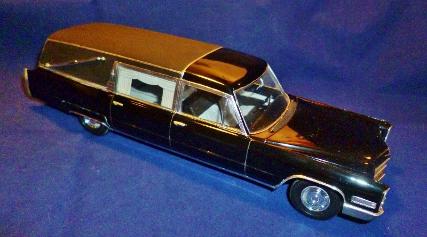
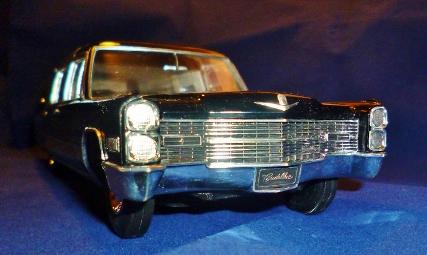
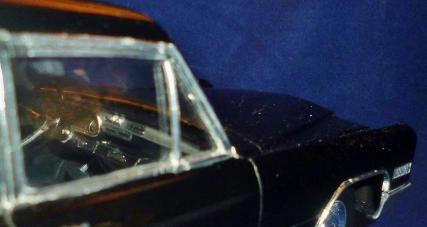
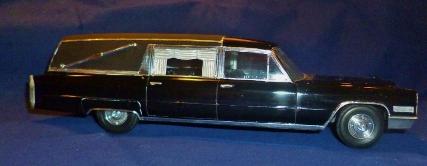
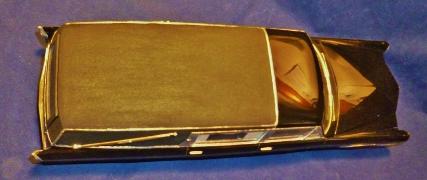

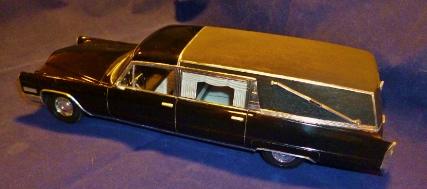
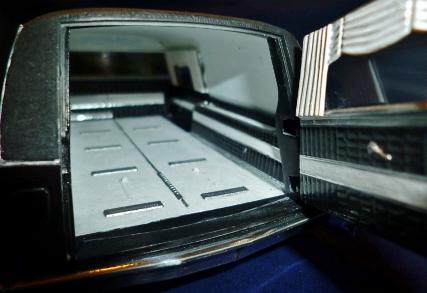
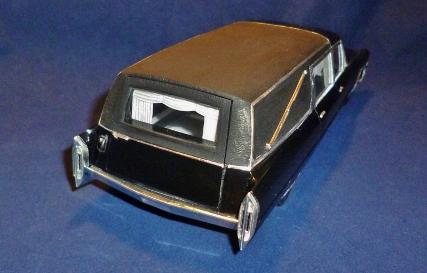
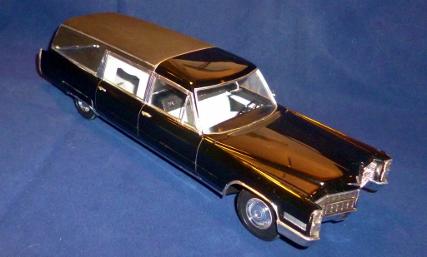
THE KIT
1966 Cadillac Heavenly Hearse (2-in-1) stock hearse or “A Wild Surf Party Machine”
This 1/25th scale Jo-Han kit, #GC-600, was first released in 1967 and was a great kit right from the start. The bonnet opens to show the V8 Cadillac engine and the rear door opens to allow a casket to be placed inside the vehicle; originally the casket was included but all later re-release versions had no casket parts.
In true Jo-Han form a number of variations were made off of the base moulds. The 1966 Cadillac “Heavenly Hearse” wild surf party kit was released in 1967 offering the builder nearly all the stock hearse parts (no casket parts remember) and a new set of additional parts, such as the roof rack for the surfboards, the scuba gear, optional custom wheels, side lamps and of course the “Wild” decals; albeit dry rub down type which are a pain to apply on concave surfaces. Confusingly this kit was also catalogued as #GC-600, although there are some references to the original kit being catalogued as #GC-600-200.
Today the 2 'n 1 stock funeral coach or custom “Heavenly Hearse” surf party machine is a very collectable item with prices for a mint kit being as much as US$140. For those prepared to wait out the long game the kit does turn up on auction sites from time to time, but, the starting prices generally seem to remain around the 70 US$ mark.
The other versions of the base kit were a Fire Rescue Ambulance, kit #GC-500 released in 1966, and two drag racing versions with additional parts and decals called “Haulin’ Hearse” (#GC-800, released in 1966) and “RRRroarin RRRrambulance” (kit #GC-1200, released in 1967). The last conversion Jo-Han did off this base kit was a 1968 Cadillac Deville Convertible titled “Boss Man”. Catalogue number for the convertible is #C-5368 but we think there are sufficient differences to consider this a different kit altogether.
Whichever version of the kit you do get it is an interesting vehicle and has cool options which keep it interesting to builders as well as collectors. While it might be a little gloomy to think there should be more hearse kits it is a fact that we all die in the end and the style of transport we make our final journey in is the ultimate offering of respect a family give.
This Kit was given to Ian by a fellow IPMS Stafford club member. Gaz discovered the kit while helping clear out a house following a family bereavement. Ian thought it respectful to build the model as a stock hearse and went ahead in 2017-2018 building the model straight from the box (although a few missing parts did have to be scratch built). After discussion with Rod, Ian thought it might be different to use the roof rack parts as a mounting for floral tributes and decided to add what was supposed to be part of the custom hearse model. These old parts are on the chrome sprue proved too fragile to use so the standard stock look was maintained.
The model is painted with “Zero” paints gloss black, “Zero” gloss and AlcladII black primer. Internally a large amount of chrome decal was used on the chrome parts as well as Molotow liquid Chrome pens and acrylic paints from the Deco-Art range. Bare metal foil was used on the dash and Citadel ink washes helped to add life to the dashboard. Applying Johnsons “Kleer” floor polish before and after the chrome decals helped to settle them and seal them in place.
The kit is very much a product of the mid-1960s era, simple construction, moulded on detailing, less than perfect fit of parts and barely adequate instructions. However, if you have a good level of experience, some patience and self-confidence then the model’s problems can be overcome.
